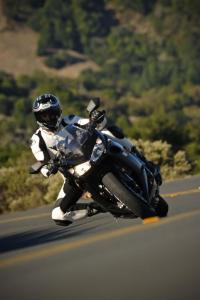 |
| Top 2013 Kawasaki Ninja 1000 Review - First Ride |
Speaking of the Ninja 1000 as a variation on the same motorcycle theme, we could nearly summarize it in one sentence and say that if you’re familiar with the Z1000 and can imagine extra wind protection and a bit more plastic, then you practically know the Ninja already.
A multi-adjustable windscreen and proper fairing is a key difference between this and the so-called “naked” Z1000.
But to be fair, this isn’t quite true. The Ninja’s above-the-triple-clamps alloy handlebar differs from the tubular bar on the Z1000. They’re about 45mm higher, 10mm narrower, and the grip angle is slightly different. Also its footpegs are set at a somewhat more relaxed position, and the Ninja’s rider and passenger saddle sections utilize 10mm more urethane padding. This extra cush should augment its long-legged comfort potential that also comes with its 1.1 gallon greater fuel capacity. And then there’s the aesthetic impression, including slightly mellower intake sound due to a deleted “intake-howl” inducing resonator that comes in the Z1000’s intake tract, and a functional full-coverage fairing with a three-way adjustable windscreen. The combined affect makes it feel like its own bike which is kind of surprising, considering on paper – as we recently documented – the bikes are so similar.
"...the Ninja 1000 is an answer to the runaway design exercise that is repli-racers..."
Kawasaki says the Ninja 1000 is an answer to the runaway design exercise that is repli-racers – which, while popular, have for more than a decade become less and less practical track-oriented machines.
The Ninja 1000 (and the Z1000) is therefore a deliberate departure to take things back toward street-riding friendliness with a liberal infusion of trickle-down technology to keep the fun quotient high, if not arguably higher on the street.
What’s in a Name?
Packing 1043cc, the newest Ninja 1000 to wear the coveted moniker since it was first coined in 1986 could justifiably be called a “1050.”
Kawasaki concedes an in-house debate took place over whether to call it a 10-something-else (not necessarily a “1050”), but those who liked the neat-and-clean “1000” name won that argument.
One hundred thirty some horses rustle past a handful of cows. We all got along fine till the farmer told us to stop our drive-by shooting in his little nook of NorCal paradise. |
And to be sure, the Ninja 1000 brand has established street cred, and perhaps that fact had a magnetic attraction to the internal compass of at least some of Kawasaki Heavy Industries’ marketers’ sensibility, and thus dictated terms.
Everyday Brutish Street Blaster
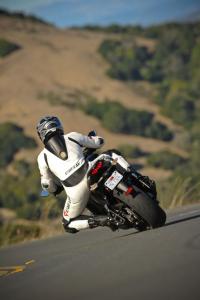 |
| Top 2013 Kawasaki Ninja 1000 Review - First Ride |
LED tail lights and twin blacked-out versions of the Z's exhausts are a couple of the styling features the Ninja 1000 carries over.
Kawasaki says the 503-lb bike’s intended demographic probably includes you. Unlike the 421-lb ZX-6R which sells hottest among 20-somethings who possess zero-to-some experience, and the 437-lb ZX-10R bought most by a similar demographic trending also into older, more experienced riders, Kawasaki is billing the Ninja 1000 as an every-person’s sportbike for every kind of riding. It is also intended to appeal to potential ZX-14 buyers who are concerned that 567-lb bike is too big or powerful, and even some mature riders who might have settled on a cruiser because they are no longer able to be comfortable on a repli-racer.
With its 5-gallon fuel capacity, optional hard saddlebags and top box, and heated grips (no prices set yet), the Ninja 1000 would make a fine sport-tourer as well.
If desired, the hard bags would make it into a reasonable match-up to the previously unmatched Triumph Sprint GT – but with a bit more power. Stripped bare, it would be perfect for Sunday sport rides, and the rest of the week would serve as an able-bodied grocery getter or transportation to school, work, or what have you – ordinary street stuff.
As a speed tool, the bike could be used for trackdays if you wanted. However, at six-feet tall, and with about a 34-inch inseam, I would have liked a little longer aft-ward space in the rider cockpit like the ZX-10R has to allow for more moving around during aggressive cornering, and braking. And if this were ours, we’d replace the stock rear tire size with a 190/55 like the ZX-10R comes with for aggressive cornering, but otherwise there are no real complaints.
I had to arch my back to play racer-boy on this one. Since the bike is also being billed as a potential sport tourer, the decreased aft-ward space might also be a concern for taller riders who may find themselves wishing for more room to shift positions for comfort on long rides. |
Care and Feeding for Your Inner Hooligan
 |
| Top 2013 Kawasaki Ninja 1000 Review - First Ride |
At 70 mph, you start to realize this bike may be more sensible and sane in some ways, but in others it has just as much if not more potential to be crazy.
Having spent hundreds of miles on the Z1000, I was instantly comfortable with the Ninja 1000, and really think the bike is too much fun. It enticed me to exploit its willingness to romp to an almost unhealthy degree, and self-control is needed to rein things in.After a day of tromping around some of the most pristine, curvy Northern California riding areas from the seacoast to the mountains and back, I polled a bunch of seasoned motojournalists and asked them whether they thought this bike had “hooligan” appeal.
Perhaps they are jaded, and perhaps there remain better choices, because some said maybe not so much – but I will step out there and put my own vote in and unequivocally say that functionally, this bike has all the appeal a quasi-reckless rider could ask for.
Possessing 44cc more than the ZX-10R, and packing 65% more peak torque than a ZX-6R which happens to hit at a reasonable 7800 rpm, it pulls like a Lear Jet on take-off. This is a bike that does everything a full-on repli-racer will on the street, but with more sensible ergonomics.
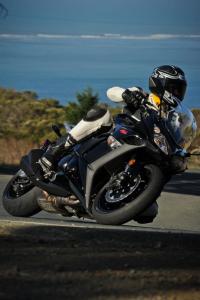 |
| Top 2013 Kawasaki Ninja 1000 Review - First Ride |
The bike is very confidence inspiring. Would like a 190/55 rear tire, but that doesn’t really hold it back. Pegs are lower than on a ZX-10R, and leaning hard will scratch the feelers.
With its not-too-tall gearing like the track-oriented ZX bikes come with, and higher center of gravity due to rider positioning, it also is a wheelie machine in first, second, and almost third gear.It was all I could do to contain myself with this beast, and I was soon testing gravity and luck in the first few gears, dragging knees, and generally trying to break it in one day.
I failed at blowing it up, but did stretch the chain enough to need it adjusted mid-route, and for the whole ride was tickled by this bike that’s supposed to be a step toward sanity that actually aids and abets the opposite.
The stiff alloy frame, wide, sticky tires, and reasonably sophisticated suspension encourage a rider to take corners deeper and deeper. The rebound and preload-adjustable horizontal back-link shock and 41mm upside down-fork – adjustable for compression, rebound, and preload – are adequate. When riding like Mad Max the bike did get a bit out of hand on really rough pavement, but it might have been dialed in further, and otherwise, we’ll say it works competently.
The radially mounted 300mm front brake rotors clamped by Tokico 4-piston calipers actuated by Nissin radial master cylinder, combined with matching single-piston caliper squeezing a rear 250mm rear rotor are more than adequate.
Actually, the bike as delivered came with brakes only half bedded in, but some quick abuse took them all the way home midway into the ride, and braking was soon strong enough to stand the bike on its nose at speed, and lock the rear wheel at will.
This happens a lot. The bike begs for it. |
The Ninja’s instrument cluster was sourced from the ZX-6R, but with different fonts and functionality. It provides the usual needed data, including a clock and bar-graph fuel gauge that did not plummet too quickly, even under spirited riding. The bend of the handlebar and not-as-rearset footpeg positioning feels natural and does not leave one wishing to get off and stretch as much after 150 miles of hard riding.
The three-position windscreen is clear enough to see through without distortion, and a lever makes it instantly adjustable without tools from nearly upright, to raceresque without need of tools. The bike looks kind of awkward with the screen upright, but that position provides the most wind protection, and the look does grow on you after a while.
Optional saddlebags shown on the Candy Fire Red/Ebony version highlights the bike’s sport-touring capability (The U.S. bike is only available in this color and Ebony). An optional top box will also be available, as will heated grips, but there will be no centerstand option. Prices on these accessories are not yet set. |
Overall, we think the bike is styled fairly aggressively and pleasing to the eye, but of course we’ll leave it to you to decide what you think. Functionally, the openings in the fairing are designed to augment airflow away from the rider, and to cool the engine, and are not a mere styling exercise.

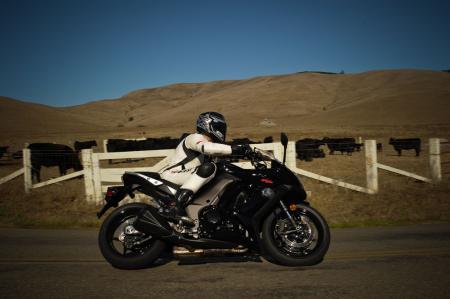
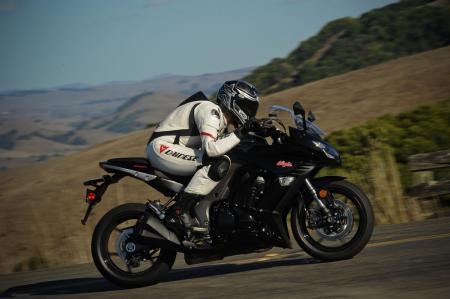
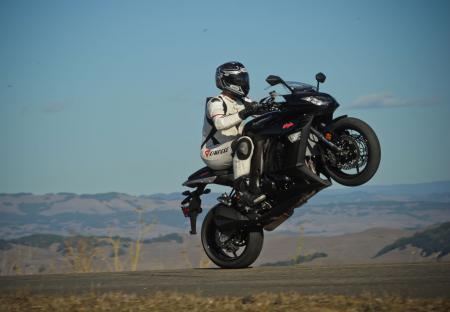
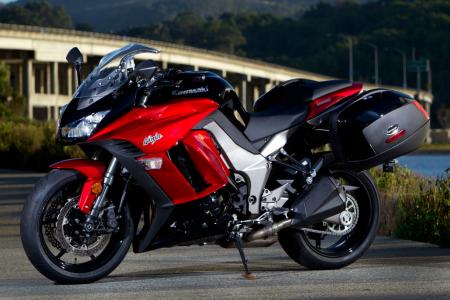
No comments:
Post a Comment